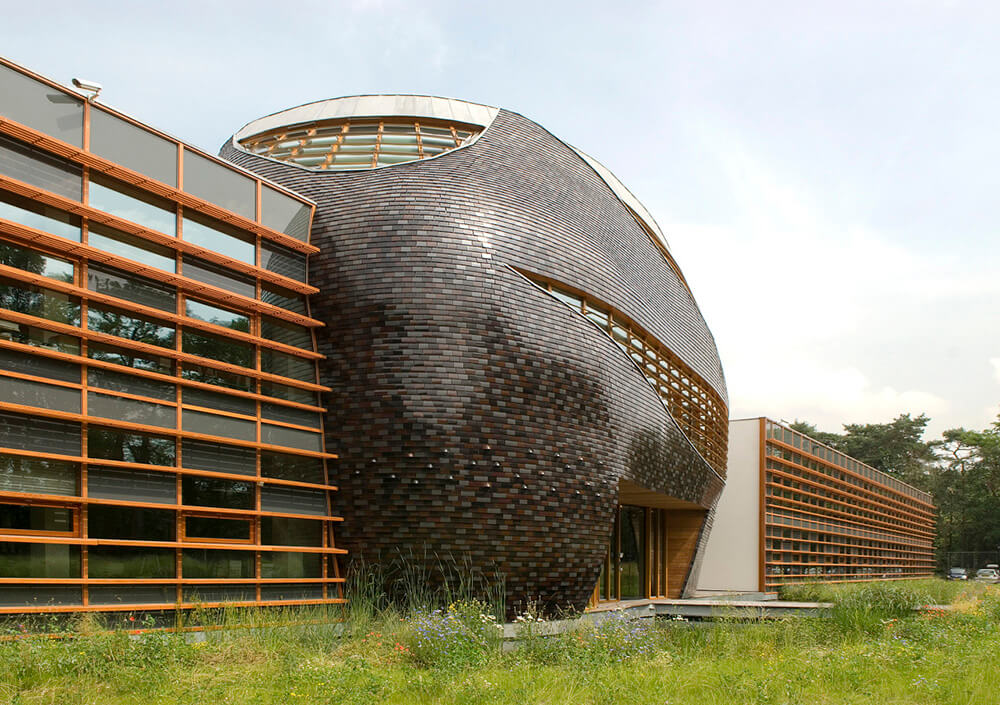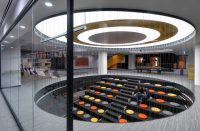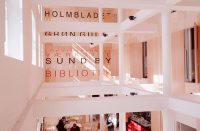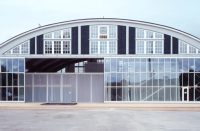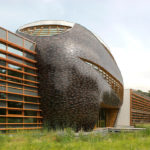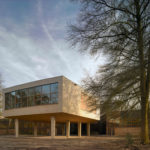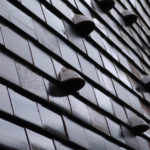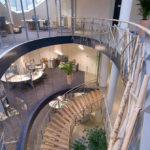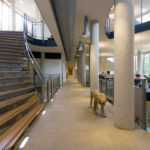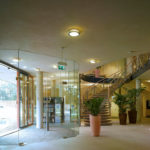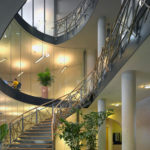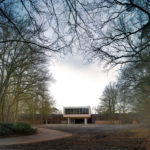Architect(s): RAU
Address: Driebergseweg 10, ZEIST, Netherlands
Latitude/Longitude: 52.074163,5.246534
RAU has transformed with this design a former 1950’s agricultural laboratory into the first CO2-neutral and (almost entirely) self-sustaining office in the Netherlands. The rejuvenated building got a friendly and inviting appearance, by breaking through the rigidity of the existing structure and adding an organic blob at the centre. Concrete was replaced by natural materials, giving a result from what used to be grey and confronting of harmony with the surrounding nature reserve. RAU’s intervention did not only give the building a new face, but fundamentally changed the user experience. A balanced and healthy indoor environment is offered with natural ventilation and the use of natural materials.
The energy performance of the building is very good; the building is CO2 neutral, it is (almost entirely) self-sufficient and achieves an A++ rating at the EPBD energy label by the European Union. Efficient isolation and heat resistance is ensured by triple glazing and wooden lamellas in front of the large windows. Solar cells on the roof generate electrical energy and solar thermal collectors are used for heating up water. Even the body heat of the building’s users is captured and re-used. Cool ground water is used for cooling the building before flushing toilets. For heating the building during winter, the architect used the surplus of warmth in the summer and stored it in a water reservoir in the ground. In the same way, for cooling in summer architect used cooling energy stored underground during winter months.
The use of renewable energy is not the only environmentally-friendly aspect of the building. Keeping the concrete skeleton of the former laboratory helped in saving energy and construction materials. All used wood is FSC-certified. The doormat is made of old car tires, the flooring is made from recycled carpets. All used materials are child labour free. An especially prepared area of the basement is used for the bats to have access and birds can nest in the façade.
Large parts of the façade are made of glass. Daylight penetrates deep into the building and offers unhindered views of the surrounding nature with this open design. The building is protected from overheating by wooden lamellas placed all around the façade. High-energy summer sunlight can enter the building only indirectly, whereas low-energy winter sunlight can pass through the lamellas unhindered. All walls and ceilings in the building are plastered with mud. As a natural building material, mud is not only available in nearly inexhaustible quantities, but is also fully biodegradable. Moisture is absoebed by mud very efficiently which is a good thermal buffer. Embedded in the mud just below the surface is a mesh of fine capillary tubes covering large areas of the ceiling. The building is heated and cooled by pumping warm or cold water through the tubes.
Because the system works with very large surfaces for thermal exchange, the distribution of cool or warm air is very homogeneous and subtle and corresponds to the natural temperature regulation in the human body. The temperature remains balanced throughout the year, there are no headache-causing draughts or sudden temperature swings. Radiators and air-conditioning are unnecessary. In comparison to traditional systems, air quality is improved with less allergens circulating and reduced dust formation. No air-conditioning units and radiators also mean higher ceilings and a maximised use of the floor plan.
The building is divided into two zones. Around the central staircase in the blob, all public functions are grouped together such as the reception, the call centre, a shop and meeting rooms. The open atmosphere is emphasized with glass walls in this part of the building. The non-public functions are accommodated in the two wings of the complex. A more calm environment is created by a smaller scale floor plan, allowing employees to focus on their work without distraction. The first floor of the complex has a flexible layout so that it can partly or entirely be let to third parties.
The WWF expected its identity to be seen through the design of the new head office, as it is one of the world’s foremost environmental organisations. With its outstanding energy performance, healthy indoor environment and the use of child labour free, environmentally-friendly materials the building meets high standards of sustainability. This is true for its integration into the natural surroundings, as it is for the complex itself. The old laboratory had some parts that eventually became redundant and consequently were demolished. The cleared area was handed back to nature. The immediate surroundings of the building were turned into a biotope, nesting boxes in the façade offer breeding space for birds and bats can use especially prepared parts of the basement as an extension of their natural habitat. Whereas the old laboratory stood in stark contrast with its environment, the transformed building enters into a dialogue with nature, thereby reflecting the core values of the WWF.

